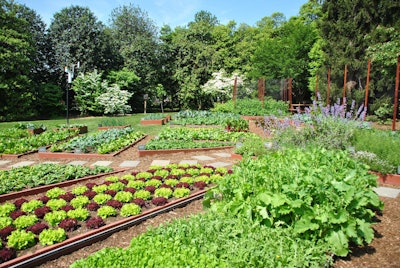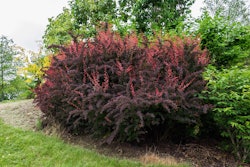 Photo: angela n./Flickr
Photo: angela n./FlickrMany of your customers may be familiar with edible gardens, but how many are equally as familiar with kitchen gardens?
Kitchen gardens are gardens that are close to a home’s kitchen where fruits, herbs and vegetables are grown for cooking and eating. While the concept may be similar to edible gardens, the overall design differs a bit.
Edible gardens tend to resemble traditional gardens, whereas kitchen gardens are a bit more formal, organized and can resemble the layout of a kitchen.
The overarching theme for kitchen gardens is to encourage customers to treat the plants like a kitchen. Want an apple? Go grab one off the tree in the backyard. Want some broccoli? Pick it right out of the garden. Want some smoothies or salads? Grab some berries or kale and have at it.
Take a look at a few tips for designing a kitchen garden your customers will literally eat up.
Plant a living/green wall
When plotting out space for your customer’s garden, keep in mind that living walls can help take advantage of vertical space. We’ve talked before about the benefits of green walls, but let’s recap for just a second.
According to the company Ambius, which specializes in green wall installation, green walls are panels of plants which are grown vertically using hydroponics. They can be grown on free-standing structures or can be attached to walls.
These walls can easily be covered in a variety of herbs, beans and other edibles, and they will be in easy reach as they grow higher on the wall. Adding in some festive-looking edibles will also give the wall a nice pop of color to accompany its tasty nature.
To learn more about the benefits of green walls and the maintenance required for them, click here.
Make a compost bin
Creating a compost bin will not only help your customers get rid of unwanted materials, it will also give them more organically made fertilizer later on in the gardening process.
Compost and composted manure can improve soil structure, aid the necessary microbial activity in the soil and also releases its nutrients slowly throughout the growing season. Typical compost piles consist of anything from kitchen scraps like eggshells and coffee grounds, cardboard, leaves, grass trimmings and manure.
Use straw bales and herbs
Using straw bales might not be popular worldwide, but they have proven very useful in creating hotbeds.
Plants can be put directly into the bales with a bit of compost surrounding them, or seeds can be sown into the bale if compost is first added. With the extra heat created by the bales, crops like melons are more likely to thrive in the bale than they would in the ground.
If your clients are interested in taking this road, look into getting organic straw bales brought in to avoid accidental exposure to herbicides. Be sure to remind them to soak the bale before plants are added to it, and to keep the straw moist, as rotting straw will add to the heat it gives off.
Herbs play a crucial role within the walls of the kitchen, but they can also play an important part in the kitchen garden. Along with spicing up your customer’s culinary creations, herbs can also serve as a ground cover in the garden.
Having herbs surrounding the bottoms of other edible trees not only looks good, but it can also bring in pollinating insects.
Try out edible trees, shrubs and petals
Along with colorful vegetables and fruits, why not introduce your customers to the wide, wide world of colorful and edible shrubs, trees and flowers?
Edible flowers can be brewed into teas, used as ingredients in foods, used as decorations on baked goods or can be eaten raw. Be sure to choose carefully when picking out edible flowers, and ask your customers what kind of flavors they are looking for before picking anything out.
Trees and shrubs that produce berries and other fruits/veggies are also excellent choices to adorn your customer’s kitchen garden. They will not only add a pop of color, they will also provide your customers with a hearty helping of healthy treats.











